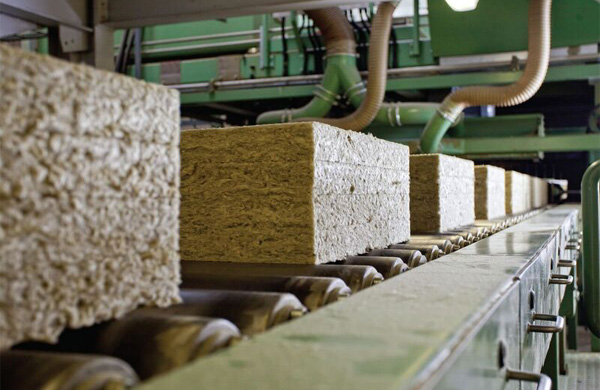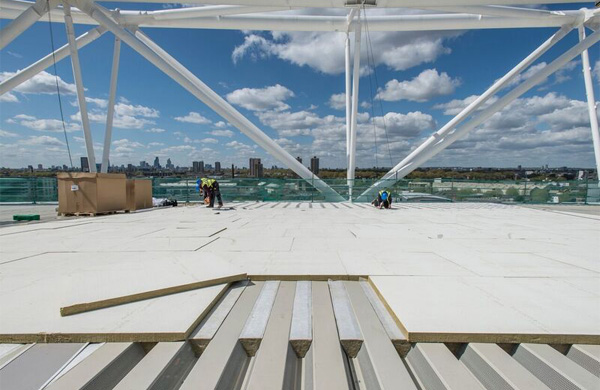
How ROCKWOOL re-engineered volcanic rock into stone wool insulation
Paul Barrett, Product Manager at ROCKWOOL, looks at where stone wool insulation began and how it evolved into a thermal, sound and fire safe insulation that’s capable of impressive, long-lasting performance in a wide variety of applications.
As those in the insulation manufacturing process know, not all mineral wool insulation is the same. For building and construction contractors, however, it’s sometimes difficult to understand where the distinctions lie, what benefits there might be and how the insulation choices they make can impact upon a project or application.
History
It sounds improbable, but the raw ingredient for stone wool insulation is a 200 million year old rock. Basalt is actually a base rock from when the Northern Hemisphere was first laid down.
Around the Pacific Rim and Hawaii, in particular, volcanic activity produces violent eruptions of dust pumice and strands of a material which the locals refer to as Queen Peles hair. It is formed as the molten lava falls through a cold air draft. These strands are nature’s version of what we now recognise today as stone wool.
It was around 1900 that scientists started to look more closely at the material as a potential insulant for a range of applications. The clever part was in creating their own mini volcano in factory conditions, to produce the wool in commercially viable quantities.
Production
The production process for stone wool is a technological replica of the inside of a volcano that spins and cools lava in a controlled environment.
The process begins with the base rock being graded and crushed along with other carefully selected ingredients, such as, recycled stone wool to form a raw material. This charge, as it is known, is then melted in a cupola furnace at a temperature in excess of 1500°C. As the liquid rock pours from the furnace, nature’s process is recreated. Lava flow is directed into a chamber where it is spun and transformed into rock strands and stone wool.
The spun strands are then mixed with a binder. Trillions of these strands are collected to form a matt which is then cured. Cut to various lengths and thicknesses it is then prepared and packaged to form an extensive range of products for a wide variety of applications.
Benefits
Not only is stone wool a naturally renewable and sustainable material, it also boasts a unique combination of benefits. It absorbs sound, provides a barrier to fire and retains warmth.
Reducing sound transfer
Stone wool insulation is renowned for its excellent acoustic properties. With its dense, non-directional fibre structure, it effectively traps sound waves and dampens vibration to provide an enhanced noise reducing solution.
The product can be used in three different ways to help reduce sound transfer.
Light and mid-density products work to provide airborne sound absorption – these can dramatically improve acoustic performance by ‘soaking up’ sound. Sound energy causes mechanical movement of the fibres, and fluid friction as trapped air molecules move back and forth inside the small pores – these processes harmlessly dissipate sound energy as tiny amounts of heat.
Heavier structural products can act as a resilient layer in floating floor constructions to absorb noise from footsteps and other impacts, by damping vibrations before they’re transmitted through the rest of the structure – which would otherwise be re-radiated as noise into the space below.
The heaviest products can be used to add mass to a building element, improving sound insulation. The heavier a building element, the more difficult it is for sound to pass through it.
Fully tested to meet the rigorous demands of today’s legislation, stone wool insulation is proven to reduce ambient, impact and reverberation noise.
Fire safe solutions
Created using the same process that occurs at the heart of a volcano, stone wool tolerates temperatures of up to 1000°C and does not burn.
In the event of a fire, stone wool products are designed to remain stable and slow the spread of flames. The products are fire-safe and help to protect the building’s load-bearing structure, buying valuable time for occupants to safely escape and also help to protect the building’s load-bearing structure, thereby protecting lives and investment.
Before installing essential smoke detectors, smoke control devices, fire alarms and sprinkler systems in public and industrial buildings, choose stone wool insulation and build in the first step to effective fire protection.
Stone wool fire protection products can be used as an effective barrier in a range of building applications, such as a fire shield for structural steel members, in between rooms and roof spaces, cavity barriers for concealed spaces, and a fireproof cover for pipes and ducts.
Fire stopping products help contractors conform to current fire regulations. Careful design will also ensure that fire cannot spread through cavities or along the service pipe or cable. With each service run including a different combination of plastic and metallic pipes, ducts, and power and data cables, every element will react very differently to fire. So fire stopping systems must be designed, manufactured and installed to cope with the individual needs of the project.
We’d suggest that building and construction contractors look for stone wool insulation products that have been awarded the highest possible European classification: A1 non-combustible.
Reliable thermal performance
Stone wool insulation also delivers on thermal performance. Its excellent insulating properties derive from tiny pockets of air trapped within the physical structure of the stone wool.
As well as reducing the heat needed to keep buildings warm in winter, stone wool insulation also maintains a cool interior temperature in summer. It’s energy efficient as well as being environmentally friendly all year round.
Stone wool insulation is not just for new builds. An effective way to improve the thermal performance of existing buildings is to add insulated external render systems. This causes minimal disruption to occupants and will cut fuel bills year after year.
Stone wool insulation shields buildings and their occupants, improving safety, comfort and building value.
When you understand the origins of the material and its physical characteristics it’s clear that, for contractors, stone wool should be the first choice for building insulation.
Discover how ROCKWOOL insulation harnesses the natural qualities of basalt, re-engineering volcanic ROCK to enrich the built environment.
Contact:
ROCKWOOL,
Pencoed,
Bridgend,
United Kingdom,
CF35 6NY
Phone: 01635 862621
Fax: 01656 862302
Visit Supplier's page
Latest news

24th April 2024
New technology partnership brings Passivent ventilation products to IESVE
Passivent has partnered with Integrated Environmental Solutions (IES) to make a number of its products available to model within the Virtual Environment (VE) platform IESVE.
Posted in Air Conditioning, Articles, Building Industry News, Building Products & Structures, Building Services, Facility Management & Building Services, Heating, Ventilation and Air Conditioning - HVAC, Information Technology, Innovations & New Products, Posts, Retrofit & Renovation, Roofs, Ventilation
23rd April 2024
Geberit brings Parallel World to Clerkenwell Design Week
Visitors to this year’s Clerkenwell Design Week (21 – 23 May) can step into a parallel world and discover the benefits of cleaning with water, thanks to Geberit.
Posted in Articles, Bathrooms & Toilets, Bathrooms, Bedrooms & Washrooms, Building Industry Events, Building Industry News, Building Products & Structures, Building Services, Exhibitions and Conferences, Innovations & New Products, Interior Design & Construction, Interiors, Plumbing, Restoration & Refurbishment, Retrofit & Renovation
23rd April 2024
Mitsubishi Electric Ecodan Heat Pumps and Water Cylinders to be stocked by The Boiler Shop
Mitsubishi Electric’s full range of Ecodan heat pumps and hot water cylinders are to be stocked by one of the north-west’s best established independent merchants, The Boiler Shop.
Posted in Articles, Building Industry News, Building Products & Structures, Building Services, Facility Management & Building Services, Heating Systems, Controls and Management, Heating, Ventilation and Air Conditioning - HVAC, Plumbing, Posts, Retrofit & Renovation, Sustainability & Energy Efficiency
23rd April 2024
Trio of Senior products used in new Nottingham residential scheme
Solutions from Senior Architectural Systems have helped complete The Barnum – a new residential development on Nottingham’s Queen’s Road.
Posted in Aluminium Products, Articles, Building Industry News, Building Products & Structures, Building Systems, Case Studies, Curtain Walling, Doors, Glass, Glazing, Posts, Restoration & Refurbishment, Retrofit & Renovation, Walls, Windows
 Sign up:
Sign up: 
